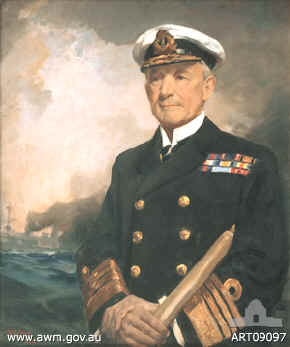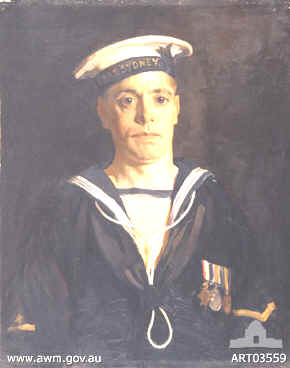|

|
| Category: Assorted/Heroes |

|
|
|
|
|
|
Some of the men who served in
AN & MEF |
|
Admiral Sir George
Edwin Patey
Royal Navy, HMAS Australia 1912-1924,
Australian Naval and Military Expeditionary Force (AN&MEF); Admiral
Sir George Edwin Patey, KCMG, KCVO, Commander of Australian Fleet;
German, North Atlantic, West Indies |
 |
 |
294 Able Seaman (AB)
William G V Williams
294 Able Seaman (AB) William G V
Williams, HMAS Una, RAN. The first recorded Australian casualty of the
First World War.
AB Williams died on 11 September 1914
on HMAT Berrima, after receiving wounds from German sniper fire during
the seizure of a German wireless station at Rabaul, New Britain.
Born in Richmond, Vic, on 24 November
1885, Williams was a Melbourne City Council employee prior to his
enlistment in the Australian Naval and Military Expeditionary Force
(AN&MEF). |
|
Able Seaman Richard
Horne
Royal Australian Navy, HMAS 1913-1928,
Australian Naval and Military Expeditionary Force (AN&MEF); Able
Seaman Richard Horne, RAN; German, Cocos-Keeling Islands (against SMS
Emden) |
 |
 |
Rabaul,
New Britain. December 1914. A group of some members of A Company, 1st
Battalion, Australian Naval and Military Expeditionary Force
(AN&MEF) on the steps of the military barracks at Namanula. A few
members of the local population are included in the photograph. (Donor
Captain W.H. Sheppard) |
| Major
General William Holmes, CMG, DSO, VD
1920; 4th Australian Division,
formerly also Australian Naval and Military Expeditionary Force
(AN&MEF); Major General William Holmes, CMG, DSO, VD, Commanding 4
Div AIF, died of wounds 1917; German, Western Front, also (Boer) War
(DSO and MID) |
 |
 |
Colonel Frederick
Arthur Maguire, DSO,
Australian Naval and Military
Expeditionary Force (AN&MEF), 9th Field Ambulance, 3rd Australian
Division; Colonel Frederick Arthur Maguire, DSO, Assistant Director
Medical Services 3 Div AIF; Germany, Western Front |
| Captain (Capt) Brian Colden
Antill Pockley, Australian Army Medical Corps (AAMC), Australian Naval
and Military Expeditionary Force (AN & MEF).
Capt Pockley was killed in action on
Bita Paka Road near Kabakaul, 11 September 1914; the first Australian
officer to be killed in the First World War.
After they encountered German soldiers
on Bita Paka Road, Able Seaman William Williams was shot in the stomach
and Pockley had given his red cross armband to another naval serviceman,
Stoker Kember, to carry Williams to the rear. This was done to protect
the transporting of the wounded Williams; Pockley was shot shortly
after.
Pockley and Williams were taken back
to HMAS Berrima, one of the ships that had carried the Australian force
to Rabaul and they both died on board that afternoon.
Six Australians were killed and four
wounded in the battle of Bita Paka. "Pockley's action in giving up
his red cross badge, and thus protecting another man's life at the price
of his own, was consistent with the best traditions of the Australian
Army, and afforded a noble foundation for those of Australian Army
Medical Corps in the war," wrote author S. S. Mackenzie in the
official history, The Australians at Rabaul. |
 |
|